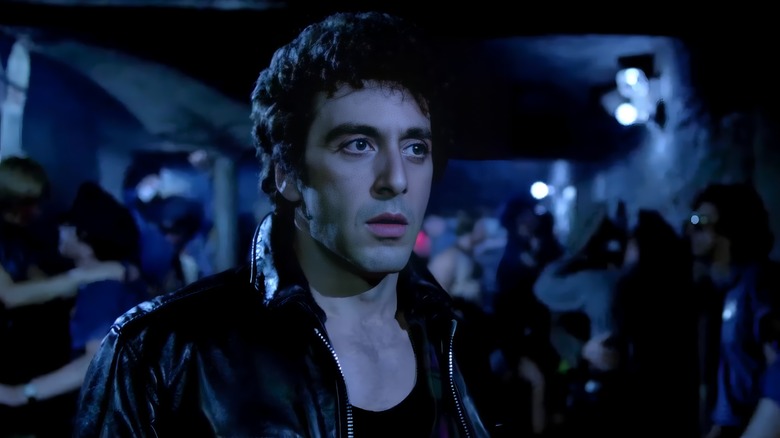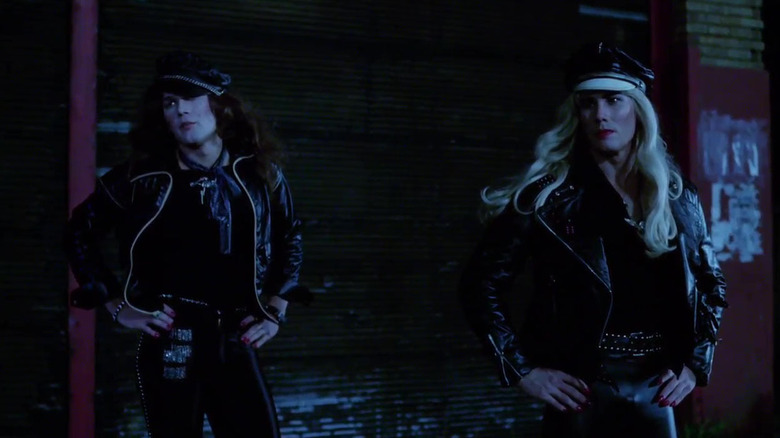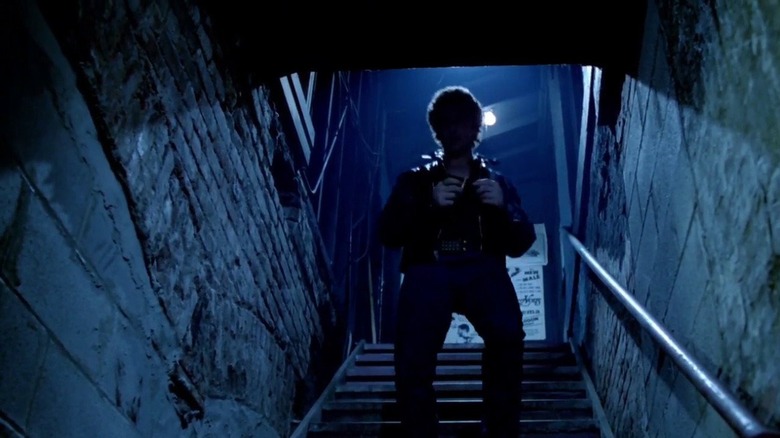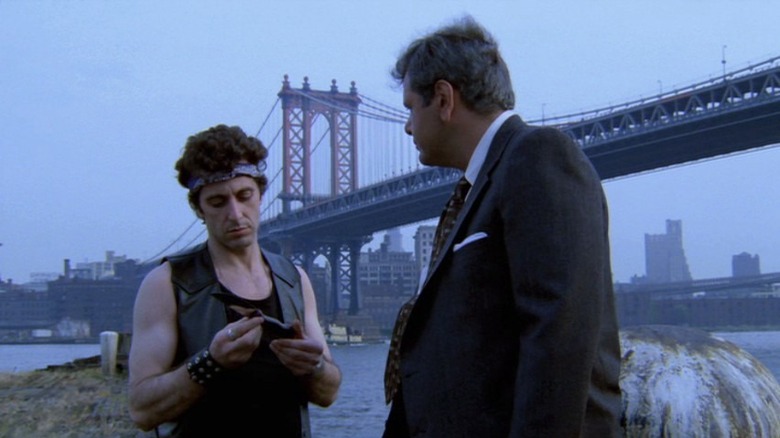William Friedkin's Most Controversial Movie Is Better Than The Critics Claimed
The recently departed William Friedkin has a fascinating relationship with the gay community, not only as the infamous director of "Cruising," but also as the director of the film adaption of "The Boys in the Band" a decade prior, a monumental work of mainstream American queer cinema (and the first Hollywood-made film to use the word "c***" on screen). It's nothing short of a miracle that a director of Friedkin's caliber is responsible for two of the most impactful queer films in history, both continually debated. But "Cruising" is on another level. Depending on who you ask, the film is either a remarkable feat or irredeemable trash, and the controversy started before Friedkin ever called "action."
Loosely based on the novel of the same name by New York Times reporter Gerald Walker about a serial killer targeting gay men in the 1970s, predominantly those in the leather scene, "Cruising" stars Al Pacino as Detective Steve Burns, an officer who becomes immersed in the gay leather scene while working undercover trying to solve the case, revealing the blatant homophobia of the police force — and the possible internalized homophobia of his own identity — in the process. The film depicts a culture in New York City that would be devastated by the HIV/AIDS epidemic just a few years following its release and transparently showcases how the systems of "protection" in America have little to no interest in protecting some of its most vulnerable denizens.
Activists disrupted filming, over 1,000 protesters marched on the East Village, and as a result, much of "Cruising" had to be overdubbed to compensate for the interruptions off-screen. When the film was released, protests erupted outside theaters across the country, and critics obliterated the film. Is "Cruising" as offensive and problematic as people claim, or was it that the world wasn't ready to unpack its importance just yet?
It had to be Friedkin
"Cruising" was originally supposed to be directed by a pre-"Jaws" Steven Spielberg, and I thank my lucky gay stars every day that this is not how things went down. I love me some Spielberg, but if a steamy leather daddy isn't going to be the one to direct this story, it should at least be a straight person with a face that looks like they're about to tell you to "go f*** yourself" at any given moment ... which made William Friedkin the perfect choice. The film was shot in actual underground S&M clubs using mostly real club members because actors at the time refused to even pretend to be gay, poppers-taking leather boys. According to Friedkin's commentary track, the first cut of "Cruising" was allegedly 40 minutes longer, mostly compiled of male pornography.
Friedkin's dedication to the film is well-documented, having immersed himself in the community by visiting the clubs and following the required dress code, lamenting in the commentary track that when he attended jock strap night, he was "the ugliest guy in the room." Look, I wasn't there, but I've seen late '70s-era Friedkin, and I'm sure with his tinted aviator glasses, he was just fine! Friedkin had already proved to the world that he was committed to telling uncomfortably nuanced stories about the gay community following "The Boys in the Band," and while we can argue for decades about whether or not a straight man should have directed "Cruising," I firmly believe that no other director would have devoted as much energy into dousing themselves into an unfamiliar and highly stigmatized culture the way he did.
As far as I'm concerned, "Cruising" is one of the most radically important works of queer cinema ever made because Friedkin prioritized veritable authenticity rather than a story that would be accessible to the cisgender, heterosexual majority.
A complicated legacy
Critical reception of "Cruising" has never been unified, and the complaints often varied. Frank Rich of TIME magazine said "This detective melodrama has something to offend almost everyone," while Brian Juergens of AfterElton said, "I wouldn't want my mother watching it, lest she think I've been in a sling in the meatpacking district for most of my adult life." The legendary Roger Ebert only gave the film two and a half stars, saying, "What could have been a powerful film dissipates its force and leaves us feeling merely confused and annoyed."
Everyone is entitled to their own opinion, but I feel as if these criticisms are rooted in what the movie doesn't do, rather than what it does. Thematically speaking, "Cruising" is a chaotic mess, but it has always felt like it was by design. As Detective Burns becomes more and more intertwined in the leather community, the more confused he becomes by his own sexuality. He seems to be fighting compulsory heterosexuality with the same vigor as fighting crime, and the film reflects that struggle.
The film's title is itself a mirror to that struggle, with "Cruising" the term used for both patrolling in a police car as well as the act of searching for a hook-up partner within gay spaces. As Anton Bitel expertly pointed out in a piece for Little White Lies, the film constantly showcases a "complete slippage between the languages of police investigation and of homoerotic activity." The best examples of this come from police captain Edelman (Paul Sorvino) who refers to police activity with phrases like "I fingered him" or "We're up to our ass in this." A lesser filmmaker would use this to draw some embarrassing "we're not so different, you and I" parallels, but Friedkin wisely elected to let the double entendre just be.
Understanding the complicated legacy
I am grateful for the work of William Friedkin, and thankful that he lived long enough to see the revised reclamation of what he once thought was "his worst movie," now understood as one of his most important. James Franco and Travis Mathews created the docufiction film "Interior. Leather Bar.," which depicts an attempt to recreate the lost 40 minutes of footage from the film. The eleventh season of "American Horror Story" is essentially just a series adaptation of "Cruising" with more horror elements, down to a shot-for-shot recreation of a hulking man in a jockstrap and cowboy hat entering an interrogation room to smack the taste out of the mouth of a person of interest.
But I consider it a privilege that I was able to come to "Cruising" removed from the recency of the HIV/AIDS crisis, as well as the Stonewall Riots, which took place only a decade prior to the filming of the movie. This means that I did not have wounds still struggling to heal when this film came about, nor was I actively mourning the losses of my loved ones and community. The weight of those who were lost and the gravity of what my elders went through to build a world where I can be a loudmouthed lesbian with a visibly transgender wife is something I do not take lightly, but it means that much of the history of my community exists for me in the theoretical. The LGBTQIA+ community might as well have been an exposed raw nerve in 1979, and I do not condemn anyone who felt the need to condemn "Cruising."
But in 2023, "Cruising" should no longer be treated like the very real people forced to exist underground out of the sight of "polite society." This is not a film that demonizes queerness or even the S&M subculture of public fistings and flagging in public parks. Indeed, "Cruising" is a film that points out the deadly dangers of homophobia — both the systemic and the internalized.



